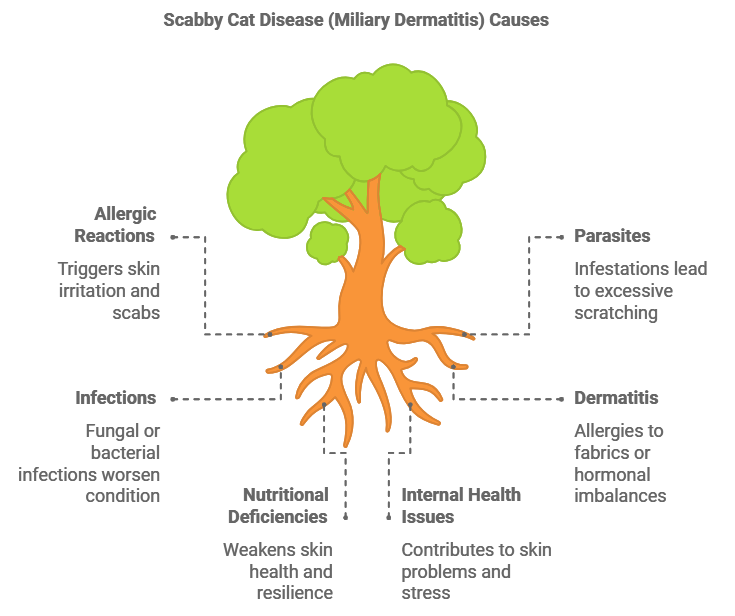If you’re a cat owner, you’ve probably wondered about those scabs on your cat’s skin. Feline miliary dermatitis is an allergic reaction that causes scabby and irritated skin in cats. It might seem alarming when your indoor-only cat develops these scabs, but it’s often not a severe health problem.
Scratches, bites, or even more serious conditions can lead to these scabs. Understanding the causes and seeking treatment, like immunotherapy, will help keep your pet’s health in check, ensuring their well-being.
Scabby Cat Disease Overview (Miliary Dermatitis)
What are These Scabs on Your Cat?
Feline miliary dermatitis is a common skin condition in cats, often caused by an allergic reaction. This reaction forms small, crusted lesions on the skin, resembling millet seeds. The term “miliary” comes from milium, the Latin word for millet. Vets often describe the condition as a pattern of lesions on a cat’s skin, appearing on the neck, head, and back.
If you’re noticing scabs on your cat’s skin, it’s important to understand that these scabs act as protective layers over wounds or sores. While they may vary in size, color, and texture, they usually form when your cat is scratching or biting due to irritation. The scabs can appear on the back, neck, or tail, depending on the cause.
Some common causes of scabs in cats include:
- Allergic reactions to flea bites, food, or pollen
- Parasites like fleas or ear mites
- Infections, either fungal or bacterial
- Dermatitis, which can result from an allergy to fabrics or a hormonal imbalance
These scabs may signal a more serious health concern, so always consult a vet to determine the best treatment. This will ensure your fluffy friend stays healthy and comfortable.
Signs of Scabby Cat Disease (Miliary Dermatitis)
Scabby cat disease, or miliary dermatitis, often appears when cats experience an itchy rash or irritated skin. It tends to affect areas like the lower spine, base of the tail, face, ears, neck, and belly. The cats may lick, bite, and scratch these areas excessively, leading to scabs and potential infections.
Symptoms may include:
- Small lesions that develop into crusty scabs
- Excessive grooming, causing thinning of the hair coat
- Constant scratching of the affected areas, especially around the head and back
This condition can result from allergic reactions triggered by fleabites, environmental allergens, or food sensitivities. Veterinarians recommend at-home treatments but advise consulting them first to avoid worsening the rash or causing further self-trauma.
If you see red bumps, scabs, or notice a cat behavior change after abortion, it’s best to visit a vet to rule out serious issues. Monitoring changes in the color of the cat’s nose can also help identify underlying conditions.
Causes of Scabby Cat Disease (Miliary Dermatitis)
Miliary dermatitis in cats is commonly caused by flea bites, leading to allergic reactions and irritated skin. Even a single bite can provoke a severe skin reaction in sensitive cats. Other causes include:
- Ear mites, skin mites, and deep hair follicle mites
- Pollen allergies or food allergy dermatitis
- Environmental allergens and nutritional deficiencies
In addition, bacterial infections, ringworm, and drug hypersensitivity can worsen the condition. Flea bite hypersensitivity is particularly common in warm-climate areas and flea-infested regions. In cold-winter regions, this condition often appears in summer months when fleas are more active.
Internal health issues such as immune-mediated diseases, certain types of cancer, or stress may also contribute. If you notice your small cat head scratching excessively or see sores from cat injury or trauma, it’s important to check cat’s temperature and monitor their skin closely.
Excessive scratching and grooming can result in further complications like fungal infections, immune system disorders, or sores. Monitoring your cat’s skin, behavior, and overall health is essential to managing the condition effectively.
3 Effective Remedies for Scabby Cat Disease (Miliary Dermatitis)
Flea, Mite, and Lice Treatment
If your cat has scabs caused by miliary dermatitis, fleas, mites, and lice are often the main problem. Blood-sucking pests like these can lead to scabbing and bleeding due to constant scratching. Start with flea treatment, lice treatment, and mite treatment to reduce pests. Topical treatments and oral medications can be effective, but always consult a vet before using any treatment.
- Use over-the-counter options cautiously but consult your veterinarian for stronger topical treatments or injectable medications if needed.
- Keep your cat’s environment clean to prevent reinfection.
Itch and Pain Relief
Cats with miliary dermatitis often experience intense itchiness. To reduce this, consider steroid creams or topical treatments to help ease scabbing and prevent scratching. Over-scratching can make the site worse, leading to further bleeding. Veterinary offices might offer stronger, prescription-based solutions to manage itchiness more effectively.
If you notice your cat keeps biting or scratching the affected area, contact your cat’s veterinarian immediately for stronger methods of relief.
Food and Environmental Allergies
A food allergy or environmental allergy might be triggering your cat’s scabs. In some cases, trying an elimination diet using nonprescription food or prescription food over 8 weeks can show improvement. The food prescribed by your vet may help to narrow down the diet causing the issue. If successful, you can gradually reintroduce your cat to their regular diet while keeping an eye on their symptoms.
Regular Vet Consultations and Follow-ups
For a complete solution, ensure regular vet consults. A thorough checkup will address any hidden parasite problems, like pests or bug bites. The veterinarian will also check your cat’s grooming habits to avoid further complications. If results aren’t visible, they may recommend changing the treatment or using an elimination diet under their guidance.
Diagnosis of Scabby Cat Disease (Miliary Dermatitis)
For proper diagnosis of feline miliary dermatitis, the cat’s medical history is key. Clinical signs such as rashes and lesions on the skin can indicate a flea allergy. Checking for fleas and flea dirt is crucial since they are a common cause. The vet may perform skin scrapings and biopsies to confirm the suspected condition.
- Allergy tests and a hypoallergenic food trial can help rule out food allergies or food intolerance.
- If the condition persists, a referral to a veterinary dermatologist may be necessary to explore other suspected causes.
In some cases, the cat’s owner might notice flea feces on the skin. The vet may suggest Serum IgE allergy testing, skin swabs, or even a fecal examination for intestinal parasites. Depending on the size and kind of lesions, more biopsies may be done to get a clear diagnosis.
Clinical Treatment of Scabby Cat Disease (Miliary Dermatitis)
To treat scabby cat disease, removing any irritant or allergen is essential to keep your cat’s skin comfortable. If flea allergy is the issue, a flea preventive can help stop the clinical signs from worsening. Topical treatments are often used for parasite infections like mites or lice, targeting specific infections.
In some cases, a hypoallergenic food trial may be suggested, especially if a food allergy is suspected. Antihistamines or essential fatty acids may also help in reducing itching or discomfort by addressing the allergy component. My vet once prescribed cyclosporine for my cat, which really helped in calming down his constant itching.
Here are some typical treatments your veterinarian might recommend:
- Antiseptic sprays or mousses to soothe the skin
- A short course of corticosteroids or other anti-inflammatory drugs for severe itching
- Silver sulfadiazine on my cat’s wounds also eased discomfort and minimized the risk of further infection.
When live fleas are found, it’s rare due to the cat’s fastidious grooming habits. However, grooming doesn’t remove all parasites, so an effective treatment is still needed. For bacterial or fungal infections, antibiotics or antifungal medications may also be prescribed for healing.
Finally, keeping your cat comfortable and minimizing scratching is crucial to prevent further skin flare-ups or irritation.
How to Prevent Scabby Cat Disease in the Future?
Keeping your cat’s skin healthy starts with vigilant care and regular vet check-ups. Regularly groom your feline friend by brushing their coat to remove excess hair and distribute natural oils. This routine helps prevent scabs and keeps fur growth consistent. Watch for unusual bumps or sores on the skin as they can signal serious conditions.
To prevent miliary dermatitis and allergy-related issues, maintain a clean environment. Essential steps include:
- Cleaning litter boxes, bedding, and toys regularly
- Frequent vacuuming to remove dust and allergens
- Using flea control products to keep fleas from returning
A specialized diet is key for cats with food allergies. Consult your vet to choose a balanced diet rich in proteins, vitamins, and minerals. This diet supports total recovery and may become a permanent part of your cat’s care, especially in allergy-prone cases.
If your cat spends time outdoors, protect their skin by reducing sun exposure or using pet-safe sunscreen. For older cats with severe allergies that worsen over time, continue regular treatments and monitor for flare-ups.
Crucial Takeaways
- Consult a vet for proper diagnosis and treatment options, including possible allergy tests.
- Treat fleas, mites, and lice using vet-recommended topical or oral treatments, especially if parasites are the cause.
- Use itch relief methods like steroid creams or prescribed medications to ease discomfort and prevent excessive scratching.
- Adjust diet if food allergies are suspected, trying an elimination diet or hypoallergenic options to identify triggers.
- Keep the environment clean by vacuuming and regularly cleaning litter, bedding, and toys to reduce allergens.
FAQs
How do I treat crusty scabs on my cat?
Topical treatments like steroid creams can help reduce pain and itchiness in cat scabs, and they also work to prevent scratching or biting at the affected site. Make sure to keep your cat from licking the cream after application for the best results.
What does scabby cat disease look like?
Scabby cat disease starts as a rash that quickly progresses to small lesions with scabs from self-trauma or an allergic reaction and affects areas like the lower spine, base of the tail, face, ears, neck, flanks, and belly, often making the hair coat appear thin in these affected areas.
Is scabby cat disease contagious?
Scabies, a specific type of mange caused by Sarcoptes mites, is highly contagious and can spread quickly between pets, so it’s important for owners to recognize and treat it soon, especially since it’s uncommon in cats.
How to cure cat sickness?
After vomiting, wait 2-3 hours before giving your cat anything to eat; make sure to provide fresh water to encourage them to drink and stay hydrated, then you can offer a teaspoon of bland, low-fat food every few hours for the next 24 hours.



